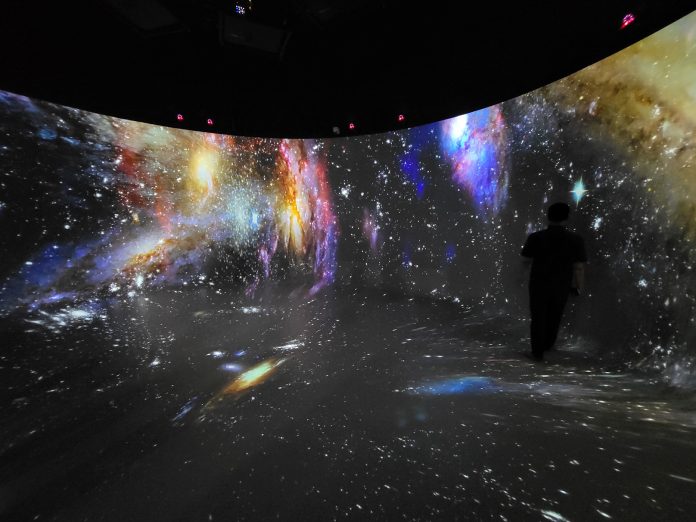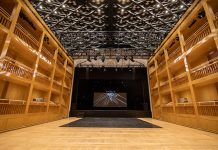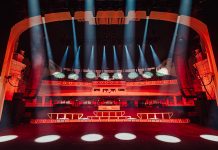VIOSO’s auto-calibration technology has been used to create a seamlessly curved 3D visualisation theatre in the cylindrical headquarters of the Korea Institute of Science and Technology Information (KISTI) in Daejeon.
The new space – a challenging, corner-free take on a classic virtual-reality CAVE (cave automatic virtual environment) – is powered by a freely hanging projector rig mounted on the 5.6m high ceiling, from which 13 Barco UDM-4K15, running dual inputs, are able to project immersive stereoscopic images on the curved walls and floor of the 9m diameter room.
Located on the campus of KISTI’s National Supercomputing Center, the VR/AR visualisation space was constructed by Seoul-based VizWave, led by managing director Hyunjoo Yun, who drew on her previous experience constructing similar systems (CAVEs, powerwalls, HoloStages, etc.) for other universities and scientific institutions across South Korea. VizWave is also responsible for the maintenance of the projection room on a long-term basis.
The sale of the VIOSO system to VizWave was managed by Norbert Schmiedeberg, managing director of ITI-Image Group in Sydney (via its former Korean joint venture, Turnstone Distribution), which has a long history of selling VIOSO products and services. The system included the VIOSO 6 SIM software, with VIOSO’s patented, camera-based automatic warping and blending technology, and a single VIOSO Fulldome Camera Calibration Kit.
Also on site, alongside Yun and Schmiedeberg, were Julia We from Turnstone Korea and VIOSO’s simulation expert Jürgen Krahmann, making the KISTI install a true team effort.
For the immersive space at KISTI, the decision was made to equip the VIOSO Fulldome Kit with a fisheye lens for calibration, explains technical product manager Krahmann. The main purpose was to minimise the appearance of squared-off corners in the projection – a common issue in most projection environments but deemed unacceptable in the rounded core of the KISTI building, which has a very tight, curved transition from the wall to the floor (described by Yun as an “upside-down dome”), making the use of a fisheye lens essential to create a more seamless and immersive experience.
The need to avoid the visibility of the corners also dictated the dimensions of the 9m by 3.5m projection set-up.
“The set-up of the projectors was the first real challenge,” recalled Krahmann, “because initially there were multiple overlaps, which is rather inconvenient for a space like this as it will destroy the black levels. Every projector emits some light, even if the output is black, so that was the first thing we needed to change.”
PERFECT GEOMETRY
Using VIOSO 6 SIM and the Hi-Res Fulldome Kit with a 185° fisheye lens and 12MP sensor, which covered the entire projection surface, Krahmann was able to get enough resolution to measure the position of all projector pixels on screen across the curvature, despite quadruple overlap and bright surfaces in the cylindrical room. This allowed the calculation of perfect geometry maps and optimal blend zones. The successful calibration was then imported into Dataton WATCHOUT, MiddleVR and WorldViz Vizard. A 10.2-channel audio system and a user tracking system with 12 cameras complete the installation.
With its new visualisation room, KISTI aims to boost the scientific and engineering role played by virtual-reality technology by connecting the VR visualisation systems to the centre’s high-performance computer equipment, such as its fifth supercomputer, ‘Nurion’, and the ‘Neuron’ GPU cluster.
KISTI vice-president Minsu Joh, who built and operated the institute’s first-generation CAVE in the early 2000s, explained that in addition to KISTI staff, the VR/AR theatre is also open for use by private researchers: “The new virtual environment has been expanded to support both VR and AR technologies,” said Joh. “We plan to continue to support not only researchers in various majors, but also small and medium-sized domestic companies, to utilise this CAVE system infrastructure.”
With the installation complete, Krahmann reflects on the KISTI project with satisfaction, recalling the important role played by VIOSO’s technology in achieving the impressive final result. “Our company may be one of the very few, if not the only one, capable of providing such a unique service,” he said. “The prospect of being at the forefront of this industry is both exciting and humbling and we are glad we could contribute to such an amazing project.”





